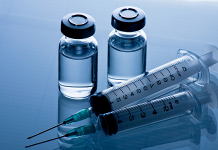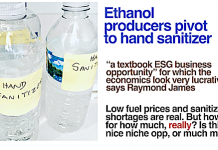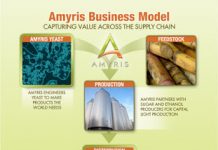Amber Waves of Gain
In South Korea, BioAmber (BIOA) and CJ CheilJedang Corporation signed a LOI for a joint venture in China to produce up to 36,000 metric tons of bio-succinic acid per year.
It’s not a greenfield. The CJCJ JV involves a retrofit of an existing fermentation plant in a market that BioAmber cannot readily penetrate today.
How is BioAmber able to convert this plant? It comes down to a low pH yeast, which allows us to leverage CJCJ’s existing fermenters and purification equipment. The retrofit will allow the partners to bring this capacity on line quickly, cost effectively and with no capital investment by BIOA.
The goal is to competitively produce bio-succinic acid in China and quickly penetrate the world’s largest succinic acid market. This can be achieved rapidly, cost effectively and with limited capital investment by retrofitting an existing CJCJ fermentation facility with BioAmber’s succinic acid technology. CJCJ would incur all capital costs required to retrofit their fermentation facility, including the capital needed during plant commissioning and startup, and production would begin in Q1 2018. If market demand were to subsequently exceed production capacity, the joint venture could expand production through debottlenecking and/or additional investment. The partners would also have a mutual right-of-first-refusal to retrofit additional CJCJ fermentation facilities globally.
The CJCJ background
CJCJ produces fermentation-based products such as feed amino acids, monosodium glutamate and nucleotides, with global manufacturing and business operations in six continents.
CJCJ would own 65% of the JV and BioAmber would own 35%. The JV would pay BioAmber a technology royalty for having access to BioAmber’s proven bio-succinic acid technology, and would pay CJCJ a tolling fee for producing bio-succinic acid on behalf of the JV. Both partners would be entitled to a share of the profits equal to their respective equity ownership positions.
The BioAmber strategy
Clearly, opportunities for BioAmber continue to emerge and the CJ announcement is a great example of this. A large commercial plant operating in Sarnia enables BioAmber to demonstrate that our technology and our cost of goods are compelling. This is attracting large strategic players who recognize the long term value of our innovative, disruptive biotechnology platform.
As we noted in our 2014 report: Why are all the traffic lights turning green for BioAmber?”
“BioAmber is avowedly pursuing a strategy based in careful aggregation of strategic partners that bring investment and offtake as well as financing relationships, while building further applications for their molecules in work with R&D partners that could be expected to translate into commercial partners down the line. Which is to say, starting with an economically and environmentally advantaged molecule and then working in partnership with downstream customers to establish markets for that molecule.
“It’s very different than the conventional biobased fuels strategy, which has been to set mandates to create market certainty, and use that to create a favorable financing environment, and encourage engagement with incumbents.”
How it all comes together
“With regards to timing, we don’t see these various projects overlapping,” BioAmber EVP Mike Hartman told The Digest. “Sarnia is in production and ramping up today. The CJ joint venture is specifically to serve the China and broader Asian market, and will come on line in Q1 2018. This will be incremental sales and cash flow that we would not likely generate if trying to import Sarnia production into China. Our second North American plant, which will expand our product portfolio to include BDO and THF, is expected to achieve a financial close at the end of 2017 and begin production in late 2019 or early 2020. CJ will take the lead in building and producing in China on behalf of the JV, which will allow our team to focus on the second plant in the US or Canada.
“The royalty and earnings stream we will start to receive from the JV in 2018 will be on top of Sarnia’s contribution, and will come with no additional capital investment. This is significant, as is the fact that we could retrofit further CJCJ fermentation capacity in the future.”
The caveats
The proposed joint venture is subject to certain conditions, including technical and commercial due diligence, with the definitive agreements expected to be signed by July 2017. As part of the letter of intent, BioAmber will be selling CJCJ bio-succinic acid manufactured at its Sarnia, Ontario plant, so that CJCJ can undertake market development in China and South Korea in the first half of 2017.
The BioAmber biobased business case
As we wrote earlier this year in “No Pain, No Gain”:
Leading the succinic charge has been BioAmber, which concluded a successful IPO and is making and shipping succinic acid out of Sarnia, Ontario. To date, sales have been at the “emerging company level”, reaching $1.1M for Q4 , including initial shipments to PTTMCC Biochem, an important off-taker requiring high purity succinic acid to make bioplastic. However, more than 100 companies tested and qualified the bio-succinic acid produced in Sarnia, and in recent weeks Mitsui & Co. invested $CDN25 million in the Sarnia joint venture, increasing its equity stake from 30% to 40% and committing to play a bigger role in commercialization.
Investors have been encouraged by an average selling price for Q4 2015 above the $2,000 / MT guidance, despite low oil prices. Overall, 2015 revenues were up to $2.2M from $1.5M in 2014, and net loss for the year narrowed to $37.2M from $48.5M in 2014. R&D costs have increased to $20.3 million from $15.2 million in 2015, driven primarily by an increase in expenses related to the commissioning and start-up of the Sarnia plant.
The company’s first commercial plant opened in August at a cost of $141.5M, and volumes specified in signed take-or-pay and sales agreements exceed annual production capacity. Should the company be able to maintain a $2,000 per ton price and reach nameplate capacity of 30,000 tons at Sarnia well, it’s not hard to get out a calculator and reach $60M in annual revenues. 2016 could well be a mighty year as the company begins to ramp up production.
The 5 Big Trends at BioAmber
We wrote about these in “When amber means caution but BioAmber means go,” here
What about Mitsui and Vinmar?
Let’s not forgt the Mitsui and Vinmar relationships.
Mitsui. As we reported in February, Mitsui this year invested an additional C$25 million in the BioAmber joint venture for 10% of the equity, increasing its stake from 30% to 40%. Mitsui said at the time it would also play a stronger role in the commercialization of bio-succinic acid produced in Sarnia, providing dedicated resources alongside BioAmber’s commercial team. BioAmber will maintain a 60% controlling stake in the joint venture.
Bioamber and Mitsui also said they would ultimately jointly build and operate two additional facilities that, together with Sarnia, will have a total cumulative capacity of 165,000 tons of succinic acid and 123,000 tons of BDO.
BioAmber’s Sarnia joint venture with Mitsui & Co. Ltd. began shipping bio-succinic acid to customers in October 2015 and
is operating its manufacturing process at commercial-scale. Management expects the Sarnia plant to increase production volumes progressively to reach full capacity in 2017.
Vinmar. As we reported in 2014, BioAmber signed a 210,000 ton per year take-or-pay contract for bio-based succinic acid with Vinmar International. Under the terms of the 15-year agreement, Vinmar committed to purchase and BioAmber Sarnia committed to sell 10,000 tons of succinic acid per year from the 30,000 ton per year capacity plant that was at that time under construction in Sarnia, Canada.
As part of that succinic acid master off-take agreement, this second plant was set be expanded to an annual capacity of 100,000 tons of bio-BDO and 70,000 tons of bio-succinic acid. Vinmar will make a 10% or greater equity investment in the expanded plant and has committed to off-take and BioAmber has committed to sell a minimum of 50,000 tons per year of bio-succinic acid for 15 years following the plant’s start-up date. Vinmar also has the option to secure additional bio-succinic acid tonnage under the take-or-pay contract if BioAmber has not committed the remaining volume at the time the plant’s financing is secured.
Reaction from the stakeholders
“While we remain focused on ramping up our Sarnia plant and building a second plant in North America, this JV is an opportunity for BioAmber to accelerate the deployment of its bio-succinic acid technology on a global scale without capital investment,” stated Jean-Francois Huc, BioAmber’s CEO. “This joint venture would allow us to quickly penetrate the Chinese and broader Asian market and accelerate cash flow and earnings for our shareholders. It would also serve as a blueprint for the build-out of additional bio-succinic acid production with very limited capital investment.”
“This JV is an opportunity for CJCJ to leverage BioAmber’s unique, low pH yeast technology and utilize our existing fermentation assets more effectively in order to competitively supply the growing market for bio-succinic acid in Asia,” added Dr. Hang Duk Roh, Head of CJ CheilJedang BIO.
Fabrice Orecchioni, BioAmber’s COO, added: “CJCJ has visited our Sarnia facility and we have visited their intended plant in China. Both partners are confident that the China plant can be reconfigured to quickly produce bio-succinic acid, for a fraction of what it cost us to build our Sarnia facility.”
Jim Lane is editor and publisher of Biofuels Digest where this article was originally published. Biofuels Digest is the most widely read Biofuels daily read by 14,000+ organizations. Subscribe here.








